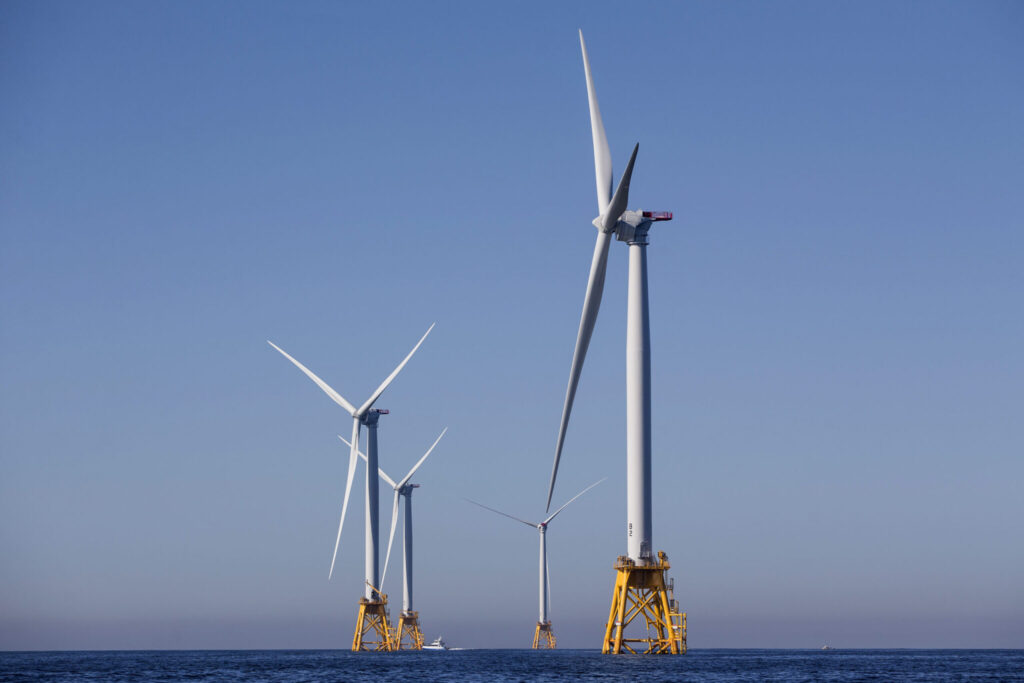The GE-Alstom Block Island Wind Farm off of Rhode Island became the first commercial offshore wind farm in U.S. waters in 2016. Wind-energy projects off the mid-Atlantic coast have developed more slowly. Photo by Scott Eisen/Getty Images.
The federal government announced Thursday that it has given final approval to a proposed wind energy development off the coast of Maryland — a significant milestone in a process that has dragged on for more than a decade.
US Wind’s Maryland offshore wind project, as approved, is expected to generate over 2 gigawatts of renewable energy for the Delmarva Peninsula, enough to power more than 718,000 homes. The federal government has estimated that the development and construction phases of the project could support almost 2,680 jobs annually over the next seven years, which is when the wind installation is expected to be fully operational.
The lease area is approximately 8.7 nautical miles off the coast of Ocean City and approximately 9 nautical miles from Sussex County, Delaware, at its closest points to shore.
The Maryland Offshore Wind Project consists of three planned phases, which include the proposed installation of up to 114 wind turbine generators, up to four offshore substation platforms, one meteorological tower, and up to four offshore export cable corridors. Two phases, known as MarWin and Momentum Wind, already have offshore renewable energy certificates from the state.
The U.S. Department of the Interior’s Bureau of Ocean Energy Management has now approved 10 offshore leases in the Atlantic, and they are slowly coming online.
“Today’s milestone marks another giant leap toward our ambitious goal of unleashing 30 gigawatts of offshore energy by 2030,” Acting Interior Deputy Secretary Laura Daniel-Davis said in a statement. “Our work to approve the nation’s first 10 commercial-scale offshore wind projects is the result of the tenacious public servants at the Bureau of Ocean Energy Management (BOEM) and the Biden-Harris administration’s commitment to expedite the federal permitting process.”
The process has been anything but swift, however, and it could still encounter last-minute snags. Ocean City officials have long fretted about the proximity of the wind turbines to the shore, fearing it could hurt the town’s lucrative tourist and real estate economies, and have threatened to sue the federal government once the final approval is made public.
Federal officials said the “Notice of Availability of a Joint Record of Decision for US Wind Inc.’s Proposed Maryland Offshore Wind Project” will be published in the Federal Register in the coming days.
In July, BOEM announced the final Environmental Impact Statement for the proposed project, which analyzed the potential environmental impacts of the activities outlined in the project’s construction and operations plan and considered alternatives. BOEM hosted two in-person and two virtual public meetings last fall to gather feedback on the Maryland offshore wind draft EIS from community members, public officials, commercial fishing interests, environmental groups, tribal leaders and other ocean users.
BOEM said it has developed measures to avoid, minimize and mitigate the project’s potential environmental impacts. The Record of Decision, when it is published, will describe these measures.
Maryland, with a mandate to use 100% clean energy by 2035, has a goal of generating 8.5 gigawatts of power from offshore wind. But that effort has suffered some setbacks along the way.
Ørsted, the world’s largest developer of offshore wind, had won the lease for a second development off the Maryland coast but announced earlier this year that it was opting out of the agreement it had reached with the Maryland Public Service Commission for financial clean energy credits intended to help fund the project. The company said it would still seek permits for the proposed wind farm from the federal government, and would continue to develop construction and operations plans for Maryland, but that the current financial realities of the offshore wind industry made it impossible to continue under the present arrangement.
Some state officials believe Ørsted has effectively pulled out of the Maryland market — though the company insists that is not the case.
In June, BOEM signed a memorandum of understanding with Maryland to engage stakeholders in identifying acreage for additional offshore wind lease auctions in the Atlantic, a critical step to meeting offshore wind power generation targets for Maryland and other mid-Atlantic states.
Last month, the federal government awarded a new federal lease near the US Wind project to Equinor Wind, a Norwegian company. That site is in federal waters off the Delaware coast, 26 nautical miles from the Delaware Bay.

